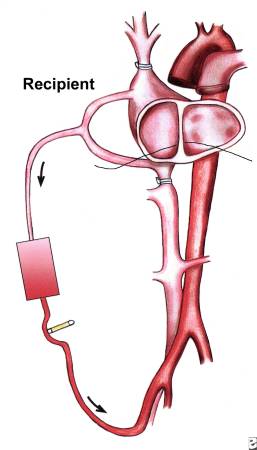Cardiopulmonary Bypass - machine, definition, history, surgery and complications

Cardiopulmonary Bypass History and Definition
Cardiopulmonary Bypass is a procedure in which a machine takes over the oxygenation and pumping functions of the LUNGS and HEART, making OPEN HEART SURGERY possible. Cardiopulmonary bypass allows the cardiovascular surgeon to stop the heart to operate on it, using the bypass machine to circulate the BLOOD through the body. Physician and researcher John H. Gibbon Jr. developed the first cardiopulmonary bypass machine during more than two decades of research and experimentation that culminated in its use to repair a congenital malformation in an 18-year-old woman’s heart in 1953. Gibbon’s design remains the foundation of cardiopulmonary bypass machines in use today.
Cardiopulmonary Bypass Surgery
In cardiopulmonary bypass, the surgeon inserts large catheters (cannulas) into the VENA CAVA and the AORTA, then administers a chemical solution to cause the heart to stop beating (cardioplegia). The cannulas channel blood through the bypass machine, which uses a membrane oxygenator to infuse the blood with oxygen and allow carbon dioxide to diffuse. Large doses of heparin, an anticoagulant medication, keep the blood from clotting, and special filters capture air bubbles. A pump mechanism, commonly roller pumps or centrifugal force, moves the blood through the bypass machine and in circulation through the person’s body. The bypass machine also cools the blood during surgery, to reduce oxygen consumption by maintaining the body’s METABOLISM at a lower rate, and warms it at the conclusion of surgery to prepare for returning the body to its own cardiovascular circulation. At the conclusion of the OPERATION the surgeon withdraws the cannulas and restores the flow of blood and the heartbeat.
Risks of Cardiopulmonary Bypass and Complications
The primary risks of cardiopulmonary bypass are blood clots and air bubbles that can cause embolism (occlusion of a blood vessel), damage to red blood cells (HEMOLYSIS), and systemic inflammatory response (IMMUNE SYSTEM activation). There is much debate about whether microemboli that slip through filtration can cause damage to the BRAIN and lungs. Some people experience neurologic effects such as cognitive dysfunction, memory difficulties, and mood swings in the months after cardiopulmonary bypass. Cardiopulmonary bypass also can affect lung function. However, for most people the benefit of the operation cardiopulmonary bypass makes possible outweighs the potential risk for these usually transitory side effects. Cardiovascular surgeons continue to explore new techniques that reduce or eliminate the need for cardiopulmonary bypass, including MINIMALLY INVASIVE SURGERY and off-pump procedures though these, too, carry risks.
See also CONGENITAL HEART DISEASE; SURGERY BENEFIT AND RISK ASSESSMENT.
Open discussion on the topic Cardiopulmonary Bypass - machine, definition, history, surgery and complications
Similar interests
- Nuovi Casino
- Casinos Not On Gamstop
- UK Casinos Not On Gamstop
- Casinos Not On Gamstop
- UK Casinos Not On Gamstop
- Casino Non Aams Italia
- Slot Sites Not On Gamstop
- Meilleur Casino En Ligne
- Non Gamstop Casino Sites UK
- Meilleur Casino En Ligne
- Casino En Ligne France
- Best Non Gamstop Casinos
- Casinos Not On Gamstop
- UK Casino Not On Gamstop
- Casinos Not Signed Up To Gamstop
- Best Slot Sites UK
- Non Gamstop Casino Sites UK
- Online Casinos Nederland
- Online Casinos Nederland
- Casinos Not On Gamstop
- Best New Uk Casinos Not On Gamstop
- Casino Non Aams
- Non Gamstop Casinos UK
- Migliori Siti Casino Non Aams
- Bitcoin Casinos